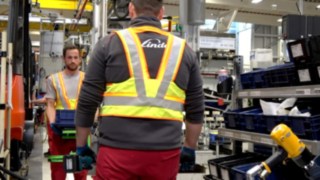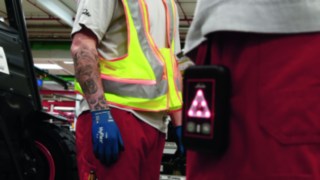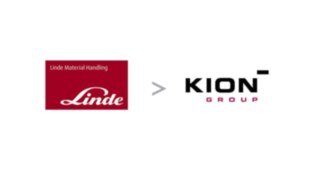
Keep a safe distance
21 Jul 2020
Smart wearables ensure effective infection protection
Am I far enough away or too close? Even if employees know how essential it is to keep a safe distance from each other in times of COVID-19, one’s instincts can be deceptive. To remedy this, Linde Material Handling presents two straightforward and highly effective solutions: The Linde Secure Distance Vest and the flexibly usable Linde Distance Beeper provide auditory, visual and haptic warnings if employees come too close to each other – thus allowing the ability to freely work with maximum protection against infection.
Whether during assembly on the production line, order picking in the warehouse or communal coffee breaks: In industrial plants and distribution centers, coming into close proximity with colleagues is often unavoidable. Against the backdrop of the coronavirus pandemic, however, such everyday situations present veritable safety risks. This applies to employees and also to companies, who in the worst case could be forced to shut down their business operations if an infection occurs.
How can the new distancing rules be effectively implemented without disrupting work processes? Intralogistics specialist Linde Material Handling provides a smart answer to this question in the form of the Secure Distance Vest. The name says it all – this wearable safety device, which is certified according to the EN ISO 20471 safety standard, continuously monitors compliance with regard to the individually configurable minimum distance required between employees. If they get too close to each other, the vests emit alerts in the form of flashes, warning tones and vibrations.
To do this, they use extremely reliable and accurate ultra-broadband technology, which works even through walls, shelving and gates. A further advantage is that no additional technical infrastructure is required; as soon as employees have put on their intelligent clothing, they can fully concentrate on their work without having to constantly assess whether they are maintaining the prescribed distance. If a case of infection occurs in the company nevertheless, the – optionally available – additional “Tracking & Tracing” function makes it possible to find out who has been in the vicinity of the person who tested positive. In this way, companies can avoid having to quarantine the entire workforce. All data is deleted after four weeks at the latest.
The Secure Distance Vest was developed based on the well-established Linde Safety Guard assistance system, which warns of collisions between industrial trucks and pedestrians in intralogistics environments. The second solution Linde has adapted to meet the new requirements resulting from the coronavirus pandemic also originates from this product family. Dubbed Distance Beepers, these small, portable units are attached to clothing, belts or by means of wristbands, for example, and offer companies the same range of functions as the Secure Distance Vest: maximum safety with minimum implementation effort.
Remarkable: The investment in these smart safety solutions from Linde Material Handling will continue to pay off even once the pandemic is over. The vests and beepers can be easily converted to the classic functions offered by the Linde Safety Guard and will then warn of collisions with forklifts. Conversely, this also applies to “Safety Guard” systems that are already in use by customers: These can be reprogrammed in line with the new distance warning used for infection protection.

The Linde Secure Distance Vest and the flexibly usable Linde Distance Beeper provide auditory, visual and haptic warnings if employees come too close to each other – thus allowing the ability to freely work with maximum protection against infection.

The Linde Secure Distance Vest and the flexibly usable Linde Distance Beeper provide auditory, visual and haptic warnings if employees come too close to each other – thus allowing the ability to freely work with maximum protection against infection.
“Times like these require unconventional thinking,” says Andreas Krinninger, CEO of Linde Material Handling: “With our Secure Distance Vest and the Distance Beeper, we have adapted a sophisticated system to new circumstances and offer companies a simple option for preventing infection chains and thus maintaining their operational capability. Both solutions are already successfully being used at several of our own locations – and we are also receiving very positive initial feedback from test customers. Moreover, the fact that the tools can continue to be used for occupational safety purposes once the pandemic is over makes the investment extremely sustainable.”

